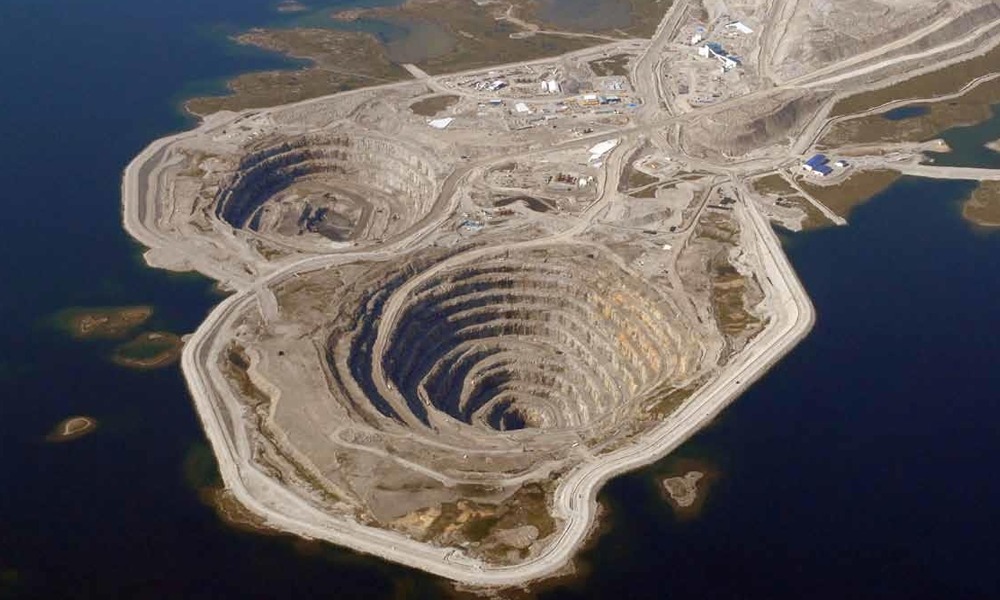DiamondBuzz
Rio Tinto records 27% y-o-y rise in output for Q1 2025 primarily driven by Diavik diamond mine

Rio Tinto reported a significant 27% year-on-year increase in diamond production for Q1 2025, reaching 942,000 carats compared to 740,000 carats in Q1 2024. This growth was primarily driven by operational improvements at the Diavik diamond mine in Canada’s Northwest Territories, Rio Tinto’s sole operating diamond asset. The strong quarterly performance marks a robust recovery after a volatile 2024, positioning the diamond division for a stronger 2025.
The Diavik mine processed 394,000 tonnes of ore in Q1 2025, up from both Q1 and Q4 2024, reflecting enhanced operational efficiency and throughput. The Q1 2025 output is a marked rebound from the 542,000 carats produced in Q3 2024, when production was hampered by temporary mine closures due to safety concerns.
The Diavik mine is currently Rio Tinto’s only diamond-producing asset, following the closure of the Argyle mine in Australia in 2020.
The surge in output is attributed to: Successful ramp-up of underground mining at the A21 pipe, following the completion of the first phase of development. Increased ore processing volumes and improved operational efficiency. Recovery from previous disruptions, including a temporary shutdown in Q3 2024 due to ground instability in the A154 underground region.
The extension of Diavik’s mine life signals confidence in the long-term fundamentals of the diamond industry, even as global supply and demand dynamics remain volatile.
BrandBuzz
De Beers Group Rewrites the Diamond Story with ‘Intention Pendants’ for the Woman Who Chooses Herself
Where natural diamonds become expressions of intent for women shaping their own path

De Beers Group taps into the modern ritual of intention-setting with the launch of ‘The Intention Pendant’ collection, where natural diamonds become intimate expressions of purpose and personal power. Designed for the woman who marks her milestones quietly yet deliberately, the high-glamour collection reflects a new language of self-gifting rooted in meaning, emotion, and self-belief. The launch speaks to a wider cultural shift, one where success is defined internally and luxury becomes a deeply personal signature.
For Gen Z and millennials, practices like manifestation, vision boarding, and ‘scripting dreams’ are no longer trends; they are core lifestyle rituals. Intention-setting has become a daily act of self-empowerment. De Beers Group captures this sentiment through a personal campaign narrative that features a young woman crafting a vision board and reconnecting with her inner clarity, with the pendant serving as her constant companion through quiet moments and self-discovery.

“Women today are choosing to celebrate themselves through everyday intentions. The Intention Pendants draw from the extraordinary legacy of natural diamonds while honouring this cultural shift,” said Toranj Mehta, Vice President of Marketing, De Beers Group India. “Rooted in the extraordinary legacy of natural diamonds, this collection reflects a shift toward jewellery as a personal marker of growth. Each piece serves as a quiet reminder a woman wears for herself, honouring her inner resolve and the promises she makes to her future.”
The launch is supported by a comprehensive 360° campaign designed to inspire and engage across print, television, radio, cinema, outdoor, digital, and social media outreach. Leading Bollywood and sports icons including Tamannaah Bhatia, Athiya Shetty and Sania Mirza have created and shared their personal vision boards while wearing the pendants, amplifying authenticity and aspiration.
Each Intention Pendant features a natural diamond, formed over billions of years and shaped patiently by nature, carrying a sense of timeless continuity into the present. Refined through the forces of time, it stands as a lasting symbol of resilience and brilliance. Inspired by celestial forms and personal energy, the design brings this journey from nature’s heart to hers into a modern, wearable expression. Worn close to the heart, the pendant becomes a personal touchstone, subtly manifesting her best life while reflecting her intentions, inner strength, and the journey she continues to shape.
The Intention Pendant collection builds on De Beers’ global focus on self-gifting as an evolving expression of self-love. Across markets, natural diamonds are increasingly chosen to mark independent decisions, personal milestones, and moments of inner transformation, signalling a move beyond traditional gifting toward jewellery that reflects individuality and purpose.
Launching ahead of the year-end period of reflection, the collection aligns naturally with a season devoted to renewal, clarity, and intention. The Intention Pendant emerges not as a statement piece, but as a personal symbol, one that accompanies a woman quietly as she defines success on her own terms.
‘The Intention Pendant Collection’, serves as a reminder of one’s potential through the timeless beauty of a natural diamond and personal expression. De Beers invites you to connect with cosmic energy, flowing from nature’s core to your own.
-

 BrandBuzz9 hours ago
BrandBuzz9 hours agoMCA raises “small company” thresholds – up to ₹10 cr capital & ₹100 cr turnover from 1st December 2025, major relief for jewellery trade
-

 JB Insights10 hours ago
JB Insights10 hours agoWomen Leaders Driving the Luxury Renaissance
-

 National News14 hours ago
National News14 hours agoSHINESHILPI Announces the Launch of The Shine House, India’s Biggest B2B Jewellery Hub
-

 National News12 hours ago
National News12 hours agoTalla Jewellers Successfully Hosts Free Health Checkup Camp with Fortis Escorts Amritsar and Live For Others Foundation







